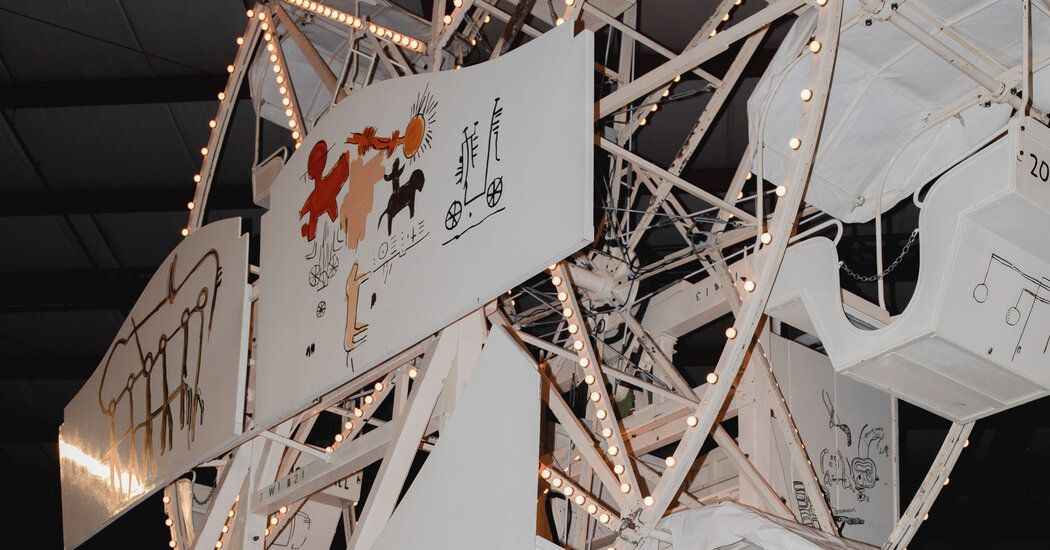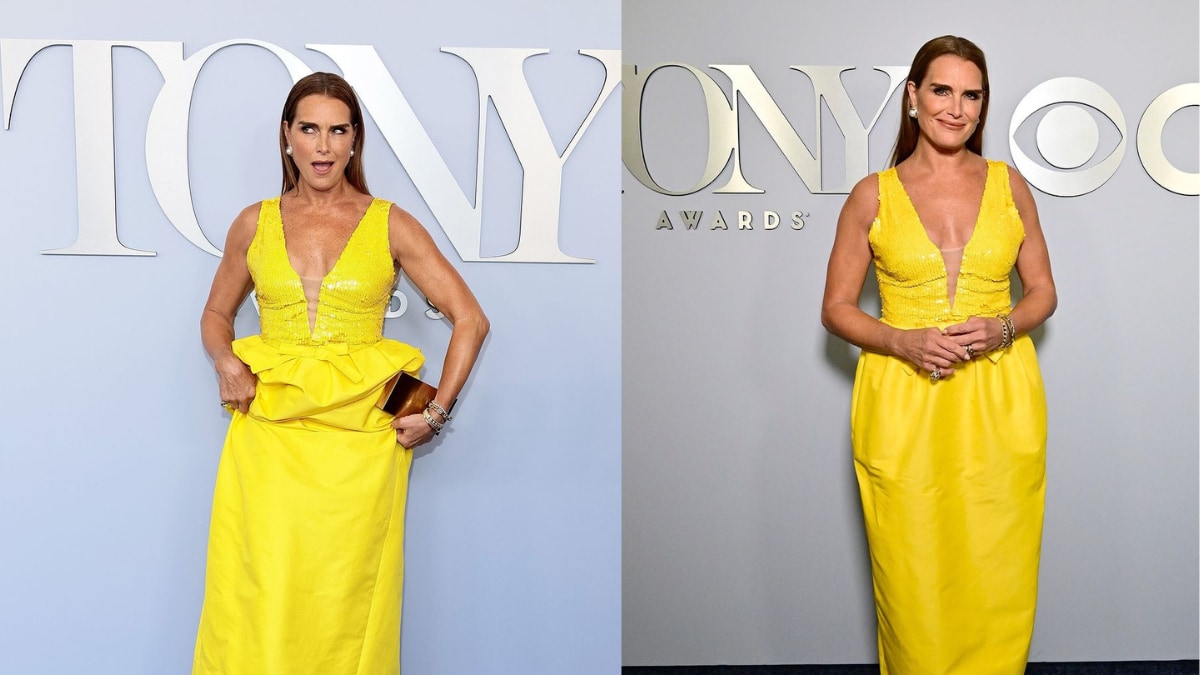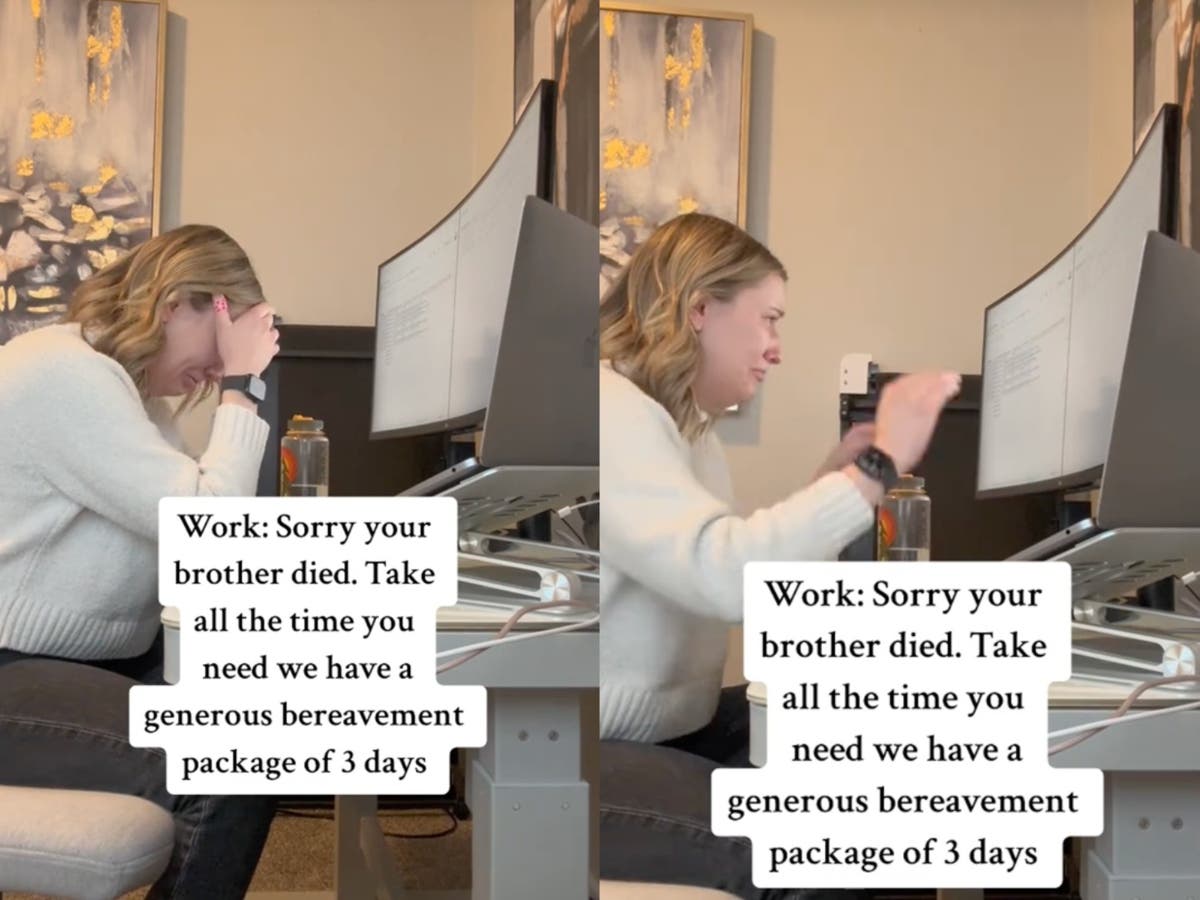What happened to the fun? In the clinical white of the gallery, art can be prohibitive, aggrieved, elitist, academic. Shouldn’t it also be happy sometimes?
The collaborators behind Luna Luna thought so. This was the amusement park that was organized in Hamburg, Germany, in 1987, where almost 30 professional artists, including Basquiat, Hockney and Dalí, designed the attractions. That summer some 250,000 people attended: families, children, students, hipsters looking for a break. But poor funding and a failed tour left the production to remain, dismantled and forgotten in a warehouse, for 35 years.
Now, at a staggering cost close to nine figures, about half of the attractions have been beautifully restored and laid out for the public in a new show in Los Angeles titled “Luna Luna: Forgotten Fantasy.”
Although I expected to spin until I was sick on Kenny Scharf’s airbrushed swing, Luna Luna is not participatory. You can walk among, but not touch, its attractions, which are installed in a black-carpeted hangar near the city center. Despite spectacular lighting, the presence of live clowns (beware), and Philip Glass’s appropriately lively soundtrack from the fair’s debut, this exhibit, with considerable didacticism, is the kind of thing a museum might put on if had the money. (Financing came privately, primarily from rapper Drake’s production company. Live Nation was recruited for the comeback.)
The magnitude and volume of the attractions allow certain highly commercialized and highly reproduced artists to impress in a new way. Keith Haring’s cartoon avatars, brought to life in candy-colored lacquer as big seats on his merry-go-round, seem to have finally found their natural habitat. As for Jean-Michel Basquiat, a pleasure craft is the most successful canvas for his inexpressiveness: on a primed white Ferris wheel, his black glyphs adorning each gondola symbolize some aspect of chaos, Americana, or slapstick, while his drawings anatomical that cover the buttresses of the wheel. mock swirl bodily emotion.
These dedicated vessels of fun seem more true to their downtown New York wrestling scene. The Mudd Club, the New Museum, the Fun Gallery. Some of these installations also fulfill the ideal fusion of leisure and pop art, as did the Mr. Freedom and Big Biba boutiques in London, or Haring’s Pop Shop in New York.
Behind velvet ropes, however, Roy Lichtenstein’s maze, about the size of a mobile home, says little. Three walls of its typical striped array geometry hide what appears to be a maze of glass panels, but the distance makes it difficult to tell. At worst, some of these stagings hint at what another parodist of the era, Weird Al Yankovic, calls “obligatory fun.”
André Heller, the Austrian businessman who organized the original Luna Luna, made it quite international, a silly biennial: its artists were also Czech, English, French, German, Spanish, Swiss and Russian. Before her death in 1979, at age 94, Sonia Delaunay, born in Ukraine and a pioneer of non-objective art since the time of Kandinsky, designed the fair’s triumphal arch. Walking through it, contemplating its spheres and panels of color divided in two, she suddenly understands the dimensional origins of abstraction. It’s fantastic.
Most significantly, Luna, which was performed in West Germany, also represented the territory then known as East: Georg Baselitz, born in Deutschbaselitz before the war, contributed a pavilion that manipulated the shadows of its participants, and Jörg Immendorff, from Post-war Bleckede built a shooting gallery. Neither is in the new exhibition, but an excellent Phaidon catalog documents the entire fair in Sabrina Sarnitz’s charming night photography.
The unspoken specter is the wall (or walls) that since 1961 divided Berlin and Germany into the communist East and the democratic West, stopping the free movement of people (under penalty of death) and, to a certain extent, of ideas. Opened just a few months before Wim Wenders’s cinematic masterpiece about partition (and circuses), “Wings of Desire,” opened in West Germany, Luna Luna appears to have evoked the internationalism that Germany long craved (and that would soon obtain, in 1989).
If you really stop to think, poke your head into a more distant political past. “Excrement Law Firm” is exhibited here, by Romanian-born culinary artist Daniel Spoerri, whose father was murdered by the Nazis. This mock-fascist façade, leaning against a warehouse wall, with victory columns topped with enormous sculptures of human effluent, originally led to the fair’s toilets.
Then there’s the “Palace of the Winds,” an oversized marquee by Austrian political cartoonist Manfred Deix that depicts adults, pants down, farting loudly and joyfully. Television screens now play images of the first performance on stage: a concert violinist and two bare-bottomed flatulists performing the “Blue Danube” waltz.
Eschatology on this scale tests the very definition of humor. (As the footage pans across the crowd, Haring can be seen blinking coldly.) But it also conveys European artists’ devotion to the absurd, a quality their American counterparts lacked and perhaps needed less of.
The real spoilsport (sorry) is Joseph Beuys. Although he did not live to see the release of Luna Luna, the German father of performance art contributed a brief manifesto. Expanded in today’s warehouse like a bus stop advertisement, this document states, quoting Marx, that “Money is not capital. Rather, capacity is capital.”
Marx? At the fair? Oh brother. But Beuys started it, so here it goes:
In 1987, Luna Luna cost visitors 20 German marks, the currency of West Germany. (Children visited free on weekdays). Today that would be about $22. By contrast, “Forgotten Fantasy” costs $38 on weekdays and $47 on weekends. (Children from 3 to 13 years old always pay $20). Family of 5 on a Saturday? With fees and taxes, that starts at about $200.
But you’ll need a VIP “Moon” pass, costing $85, if you want to interact with the three facilities that allow it: you can tour David Hockney’s wooden pavilion, with its two concentric rings of walls composed of pieces of plywood from bright colors. that fit like a puzzle and its custom-made classic soundtrack, or enter Salvador Dali’s mirror dome (for your “immersive” photo session) or “get married” in Heller’s play chapel. In the name of journalism, my friend and I got married and we can report that the fun is in watching the couple. (It should be noted that non-VIP patrons can get married for an additional $10.)
Bright blue laces indicate VIP purchase and posted QR codes invite you to upgrade. That family of 5? Now $500.30. Divide those who have from those who have more.
This exhibition was terribly complicated to make: acquisition, restoration, transportation, location, rights. But by charging like this, by establishing a staggered entrance to the same show and by promoting it with real photographs, full of children frolicking in these wild viewpoints, “Forgotten Fantasy” consolidates the exclusions – of access, of taste – that Luna Luna sought to dismantle. Power is capital, yes. But if any act can be art, as Beuys fervently believed, so must the means of encounter.
I saw kids wearing Basquiat t-shirts and Haring hoodies. I saw art people at Balenciaga. I saw groups posing for selfies and having fun. I also saw a question and, unfortunately, an answer: Who is this really for? Not those who need it most.
Luna Luna: Forgotten Fantasy
Until spring 2024, 1601 East 6th Street, Los Angeles; lunaluna.com.












